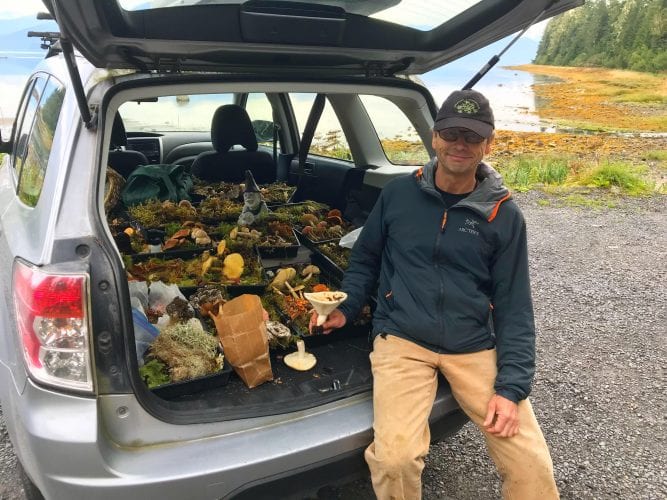
Mycologist, Ron Hamill, sits with fungi collected on Mitkof Island for the Rainforest Festival in 2018. (Photo courtesy Karen Dillman/USFS)
A dozen kids are peering down at fungi displayed in black plastic trays that cover two tables. They’re outside the U.S. Forest Service building in downtown Petersburg.
“What’s this?” one asked.
“You see the green stuff underneath, that’s a moss, and this parts a lichen,” answered Mycologist Ron Hamill. He’s leading a mushroom identification workshop for the festival.
“We have well over a hundred species here and really this is only a small representative sample of what’s actually here. There’s many many more species than this,” Hamill said. “I’ve logged over 500 species from Southeast Alaska so far and that’s still just scratching the surface.”
Hamill became obsessed with fungi when he was in college about thirty years ago. He says the forest wouldn’t be the same without it. Trees would be about human height without the nutrients and water provided by fungi.
“Really everything on Earth is mediated by fungi,” Hamill said. “They’re the great recyclers of the planet. They work in the rivers, they actually break down the fish and make those available on the plant banks. They’re responsible for many of our foods, we wouldn’t have beer or bread without fungi.”
Hamill believes educating people on the importance of fungi will help them understand the fragile nature of the forest ecosystem.
Rare species are living in the Tongass National Forest. Hamill has identified a one that has been found less than ten times worldwide.
“It’s a small brown, non-descript mushroom brown mushroom called Psathyrella Sphagnicola,” Hamill said. “It’s out in the bogs, it’s out in the sphagnum. It is here but I’ve seen it twice in five years, once here and once on Prince of Wales Island.”
Hamill says all the fungi play a specific role. Some are mycorrhizal, which join to the trees through a root system. They pass nutrients to the trees, like phosphorus and nitrogen from other “decayer” fungi that decompose forest plants. And then in turn, the trees grow bigger, and give more back the fungi.
“That increase in tree growth leads to a positive feedback loop where they’re dropping more needles, over time more wood hits the ground so it leaves more things available to recycle and release nutrients back into the system again,” Hamill said.
Another fungi—a lichen—takes nitrogen from the air and turns it into something usable for the forest.
“Which is very difficult to do,” Hamill said. “We don’t know how to do it. Our nitrogen fertilizers all come from petro chemicals.”
Sometimes it amounts to pounds of fertilizer hitting the forest floor every year.
One large tree can have hundreds of species associated with it. Hamill says that diversity is key, especially with climate change. Diversity brings strength to the forest.
“You know some of these things only function under certain temperature and moisture windows,” Hamill said. “But others may be able to–say if we have a long dry spell–others may be able to maintain some of those connections and pass along vital nutrients and even some of them provide protection from other pathogens from the tree by occupying space. So, you know, maintaining the diversity is very important, especially in a changing environment.”
The fungi workshop was just one of several workshops on and off the water during the Rainforest Festival. The event ran September 6-9 in Petersburg.











